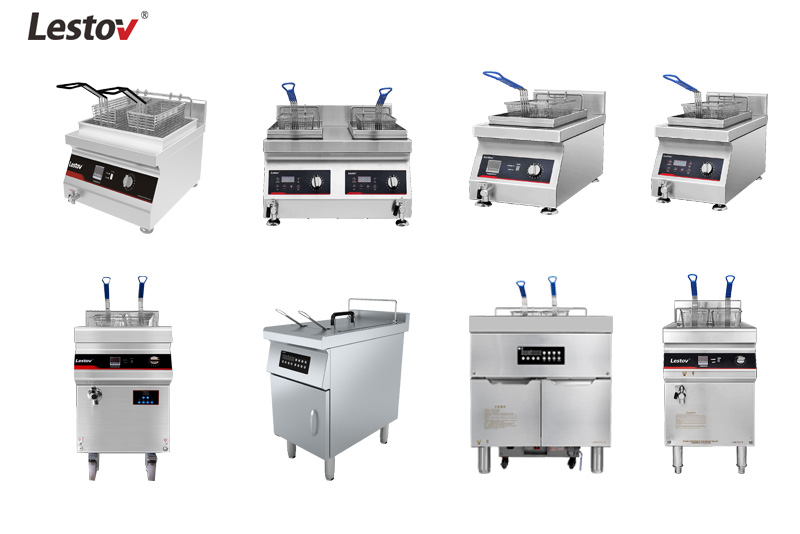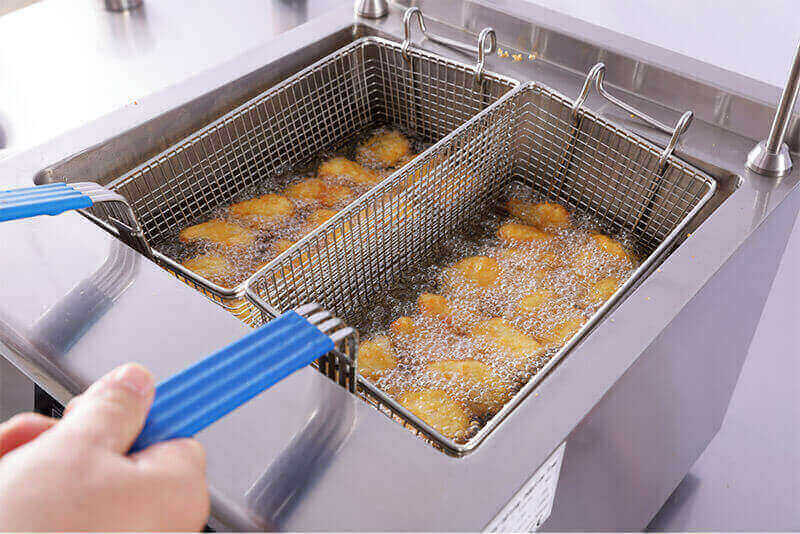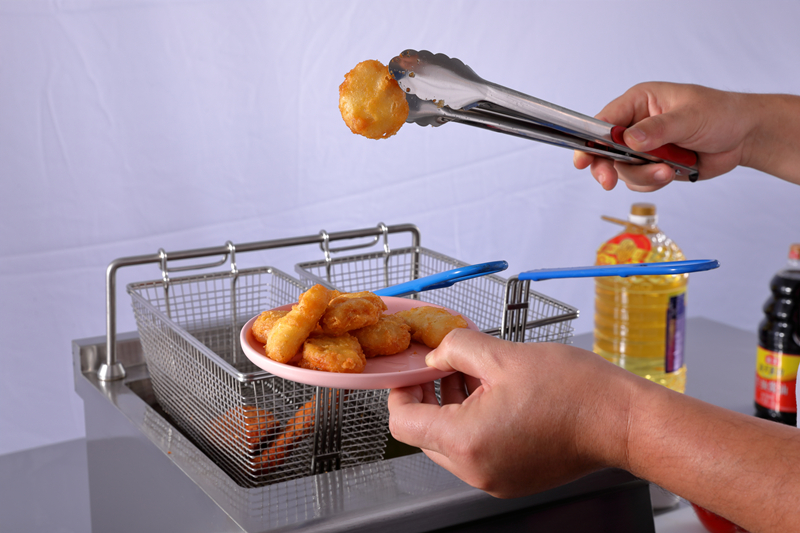In today's fiercely competitive catering industry, an efficient and stable fryer often determines the speed…

10 considerations when buying a commercial induction fryer – professional guide
In the catering industry, efficiency and precision are crucial. Commercial induction fryers are gradually becoming the new favorite of catering operators due to their advantages, such as fast heating, precise temperature control, energy saving, and environmental protection. However, faced with a wide range of products on the market, how can you choose a commercial induction fryer that suits your needs? This article will explore in depth the 10 key considerations when buying a commercial induction fryer to help you make an informed decision.
1. Power and capacity: meeting your cooking needs
(1) Power
Power determines the heating speed and efficiency of the induction fryer. Generally speaking, the higher the power, the faster the heating speed, but at the same time, the higher the energy consumption. For restaurants with significant customer traffic, it is recommended to choose an induction fryer with a power of more than 15KW to ensure efficient food delivery speed. For small restaurants or cafes, a power of about 10KW can meet daily needs.
(2) Capacity
Capacity determines the amount of food that the induction fryer can cook at one time. When choosing capacity, you need to consider your menu, customer traffic, and kitchen space. Common capacities include 10L, 15L, 20L, etc. It is recommended to choose the appropriate capacity according to actual needs to avoid wasting resources.
-
 Double Tank Commercial Induction Frying Machine LT-ZAL
Double Tank Commercial Induction Frying Machine LT-ZAL -
 Portable Dual Basket Restaurant Induction Deep Fryer LT-TZL-B105
Portable Dual Basket Restaurant Induction Deep Fryer LT-TZL-B105 -
 Single Tank Restaurant Tabletop Induction Deep Fryer with Thermostatic 8L LT-TZL-D135
Single Tank Restaurant Tabletop Induction Deep Fryer with Thermostatic 8L LT-TZL-D135 -
 Tabletop Double Tank Restaurant Induction Fish Fryer LT-TZL-S135
Tabletop Double Tank Restaurant Induction Fish Fryer LT-TZL-S135 -
 Heavy-Duty Four Basktes Induction Fryer 72L LT-ZAL-D112
Heavy-Duty Four Basktes Induction Fryer 72L LT-ZAL-D112 -
 Commercial Induction Deep Chip Fryer with Casters LT-ZLII-E112
Commercial Induction Deep Chip Fryer with Casters LT-ZLII-E112 -
 Single Tank Induction Commercial Countertop Deep Fryer LT-TZL-B135
Single Tank Induction Commercial Countertop Deep Fryer LT-TZL-B135 -
 27L Double Basket Commercial Induction Deep Fryer LT-ZLII
27L Double Basket Commercial Induction Deep Fryer LT-ZLII
2. Temperature control: Accurately control the cooking process
(1) Temperature range
Different ingredients require different cooking temperatures. Choosing an induction fryer with a broader temperature range can meet the cooking needs of more dishes. Generally speaking, an induction fryer with a temperature range of 50℃-200℃ can meet the needs of most fried foods.
(2) Temperature control accuracy
Accurate temperature control is crucial to ensuring the taste and quality of food. Choosing an induction fryer with a temperature control accuracy of ±1℃ can effectively avoid the occurrence of over-raw or over-cooked food.
3. Heating method: affects heating efficiency and uniformity
(1) Induction heating principle
Induction fryers use the principle of electromagnetic induction to make the pot body heat up, thereby achieving efficient and uniform heating. Compared with traditional resistance heating methods, induction heating has the advantages of high thermal efficiency, fast heating speed, and precise temperature control.
(2) Coil design
The design and distribution of the coil directly affect the uniformity of heating. Choosing an induction fryer with uniform coil distribution and a large coverage area can ensure that the food is heated evenly and avoid local overheating or insufficient heating.
4. Pot material: durability and ease of cleaning
(1) Material selection
Common pot materials include stainless steel, cast iron, and aluminum alloy. Stainless steel pots have the advantages of corrosion resistance and easy cleaning and are the preferred material for commercial induction fryers. Cast iron pots have good heat preservation properties but are heavy and more troublesome to clean. Aluminum alloy pots have good thermal conductivity but are relatively less durable.
(2) Coating process
Some induction fryers will add non-stick coatings to the inner wall of the pot to facilitate cleaning and prevent food from sticking to the pot. Choosing an induction fryer with uniform coating, strong adhesion, and high-temperature resistance can extend its service life.
5. Safety performance: ensuring kitchen safety
(1) Overheat protection
When the temperature of the induction fryer is too high, the overheating protection function will automatically cut off the power to prevent safety accidents such as fire.
(2) Dry-burn protection
When there is no food in the pot, or the amount of oil is insufficient, the dry-burn protection function will automatically cut off the power to prevent the pot from being damaged by dry-burning.
(3) Leakage protection
When the induction fryer leaks electricity, the leakage protection function will automatically cut off the power to ensure the user’s safety.
6. Operation interface: simple and easy to use, improving efficiency
(1) Control panel
Choosing an induction fryer with a simple operation interface and a reasonable layout of function buttons can help chefs quickly get started and improve work efficiency.
(2) Display screen
A clear display screen can display temperature, time, and other information in real time, making it easy for chefs to grasp the cooking progress.
7. Cleaning and maintenance: convenient and fast, saving time
(1) Removable design
Some induction fryers’ pot bodies, oil nets, and other parts are removable, which is convenient for cleaning and maintenance.
(2) Automatic cleaning function
Some high-end induction fryers have an automatic cleaning function, which can automatically clean the pot body and oil net, saving cleaning time.
8. Brand and after-sales service: ensure product quality and user experience
(1) Brand selection
Choose an induction fryer from a well-known brand to ensure product quality and after-sales service.
(2) After-sales service
Understand the brand’s after-sales service policy, including warranty period, repair outlets, and other information, so that problems encountered during use can be solved on time.
9. Price and cost-effectiveness: choose the right product according to your budget
(1) Price factor
The prices of commercial induction fryers vary greatly, ranging from a few thousand yuan to tens of thousands of yuan. When choosing, you need to consider your budget and make a comprehensive consideration based on factors such as product performance and brand.
(2) Cost-effectiveness
Don’t just pursue low prices and ignore product quality and performance. Choose an induction fryer with high cost-effectiveness to get more significant benefits in long-term use.
10. Other functions: improve user experience
(1) Timing function
You can preset the cooking time, and the heating will automatically stop when the time is up, making it convenient for the chef to handle other tasks at the same time.
(2) Keep warm function
It can keep the food temperature so that customers can enjoy delicious food at any time.
(3) Data recording function
It can record cooking data, which is convenient for chefs to analyze and improve cooking techniques.
Summary
When purchasing a commercial induction fryer, you need to consider many factors, including power capacity, temperature control, heating method, pot material, safety performance, operation interface, cleaning and maintenance, brand after-sales, price performance, and other functions. The 10 considerations provided in this article can help you choose the commercial induction fryer that best suits your needs and contributes to your catering business!
automatic cooking machine automatic cooking machines bbq chip fryer commercial cooking equipment commercial drop in induction cooker commercial food steamer commercial induction cooker commercial induction cooktop commercial induction deep fryer commercial induction fryer commercial induction hob commercial induction soup cooker Commercial Induction Steamer Cooker commercial induction wok cooker commercial kitchen cookware food steamer hob induction cooker induction cookware INDUCTION FRYER induction grill induction hob iron wok kitchen equipment repair guide restaurangt equipment restaurant equipment stainless steel cookware user's guidance



This Post Has 0 Comments